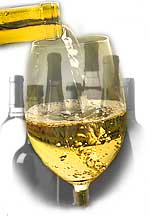
| Tips | |
| Wine test 20.11.96/Munic |
|
Our Wines
Thanks to the ideal climate of the Massandra mountains, the grapes have a high sugar content, which can be up to 35%. Such conditions are ideal for a strong, sweet dessert or aperitif wine, which can be kept a hundred years or more when stored under ideal conditions - which is the case in the Massandra galleries. Surely, some of the wines tasted can even reach twice that age. Certificate of authenticity These wines are offered at the same conditions as at Sotheby’s. So far, every single wine in the bottles we opened turned out to be in fine condition. In Massandra careful attention had been given to the wines before shipping: every wine sold at Sotheby’s had been subjected to tasting procedures before. For vintages before 1918 an approximate value is given for the alcohol content, while the information is a lot more precise where after-revolution vintages are concerned, since samples of these wines were subjected to chemical analysis. In the course of this analysis not only the alcohol content but also residual sugar and acid were determined. The residual sugar value is the sugar content remaining in the wine after the fermentation process, thus constituting the indicator for the wine’s sweetness. This, however, also depends on the wine’s
degree of acidity - the higher the acid content, the less sweet
the wine will appear to the palate. Volatile acid components are
surprisingly low in these wines, often much lower than with the
wines produced nowadays; this again confirms the extremely high
quality standard of Massandra wines.
Quality
These wines will be sold with the same conditions as Sotheby's. So far, we have had great luck with the quality of the wine after opening the bottles. Every wine sold at Sotheby´s is subject to tasting procedures. Each and every bottle is examined closely. If the bottle is in good condition it is uncorked, examined again, newly corked and sealed with a brown seal lacquer from Massandra. The corks mainly originate from Marocco and Portugal. Usually the bottles are newly corked every 10 – 20 years.
Most of the bottles were stored in the cellars without a label and therefore the family decided to stick the label onto cellophane wrapped around the bottle, instead of applying it directly onto the bottle.
Each and every bottle is carefully packed in a singular
black and gold giftbox and labelled. Wine Descriptions The descriptions on the labels are in English and
Russian. The bottles have different forms. Most of these are similar to the shouldered Bordeaux bottle, the Burgundy and the portwine bottle. The older vintages are again presented in other forms. |
![]() 1907,
The Baltic Wreck Champagne
1907,
The Baltic Wreck Champagne
![]() 1929, Muscat
White "Massandra"
1929, Muscat
White "Massandra"